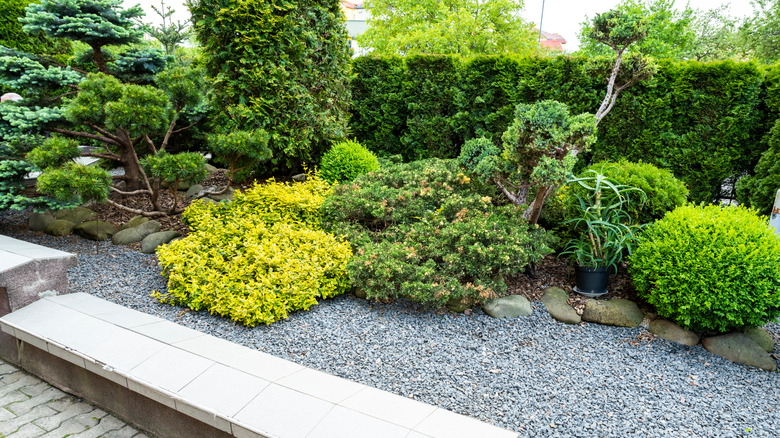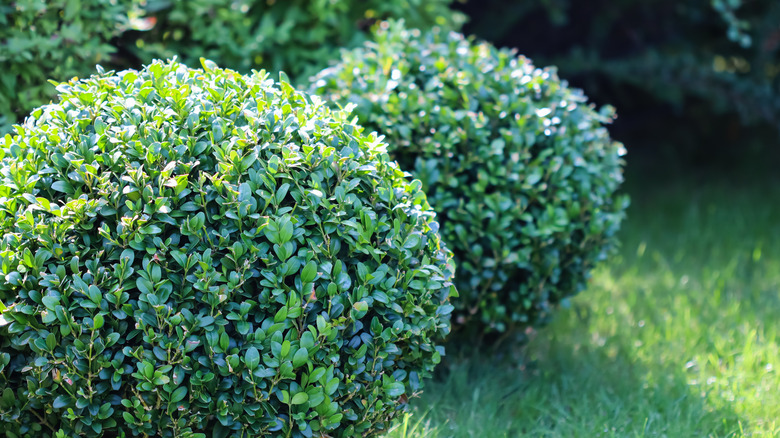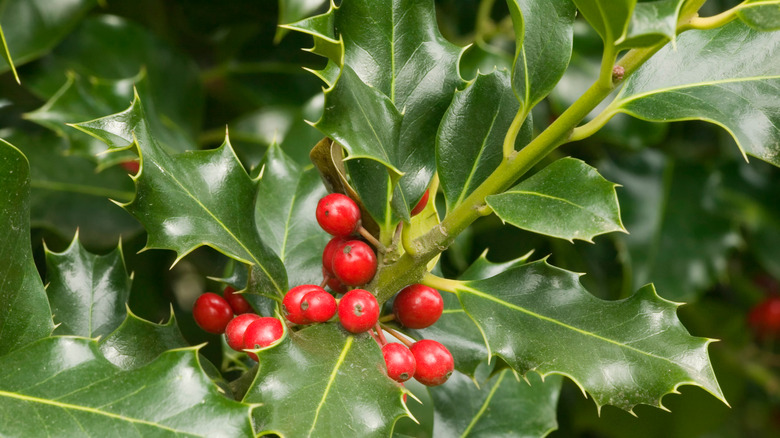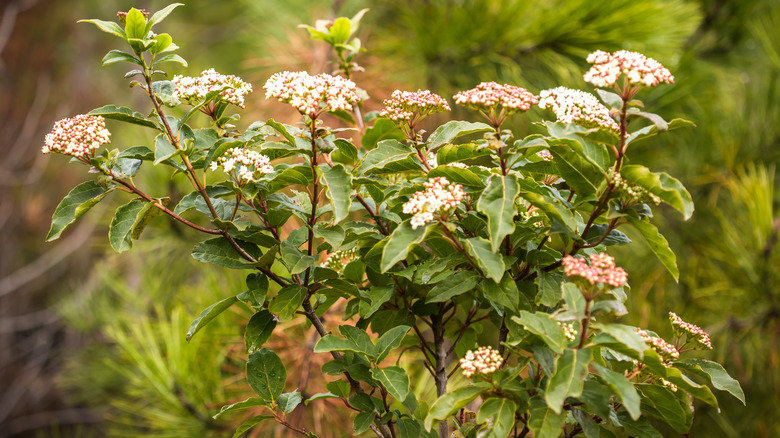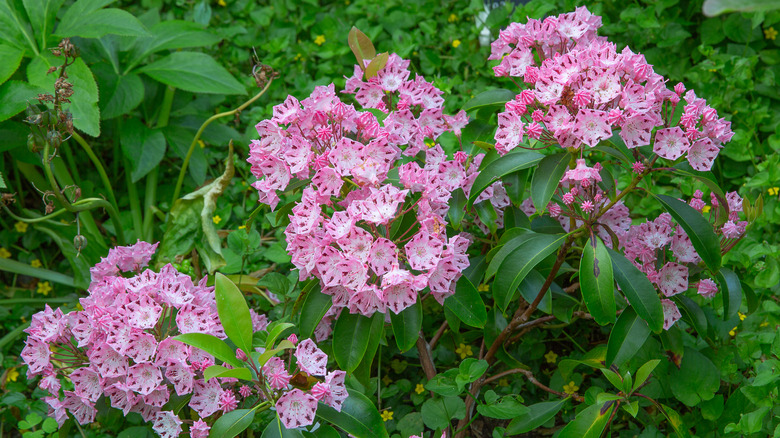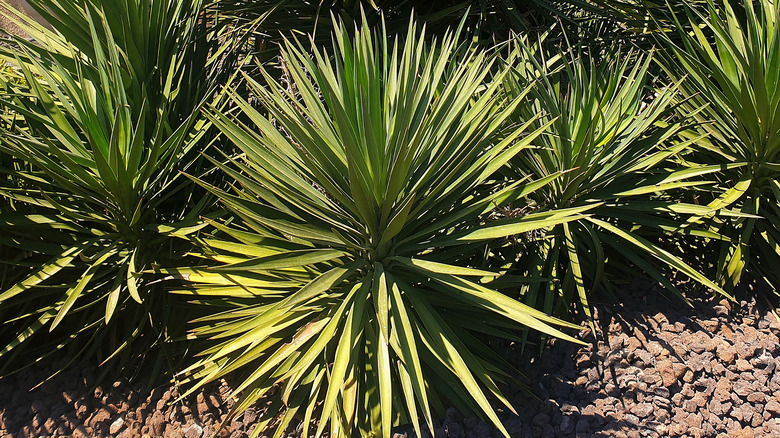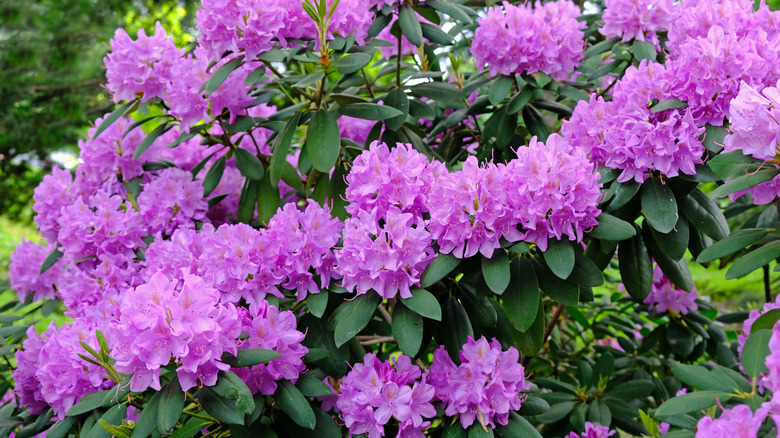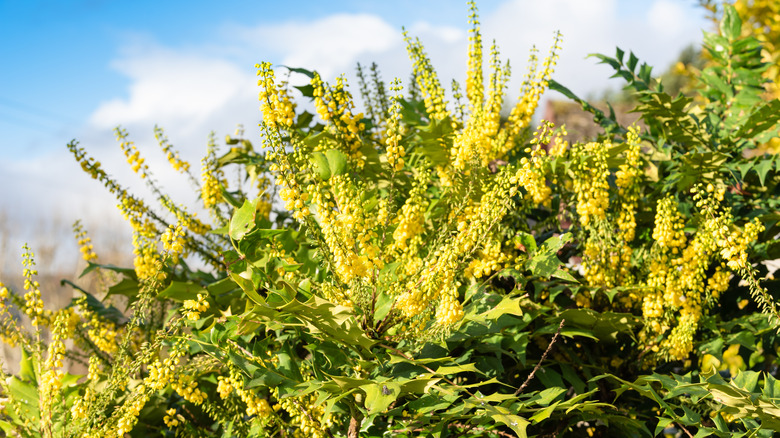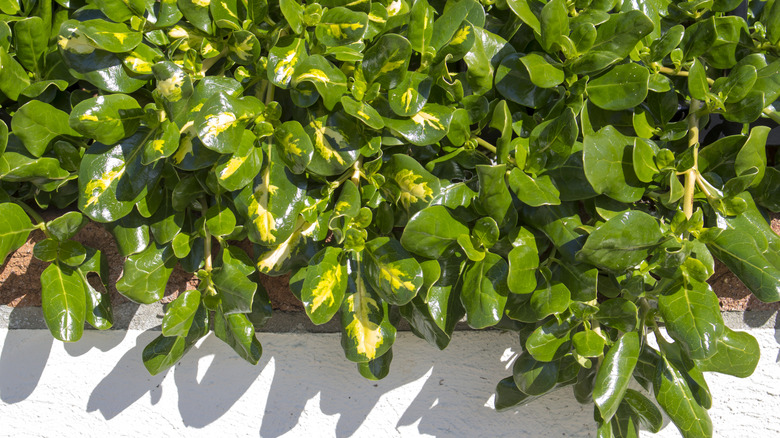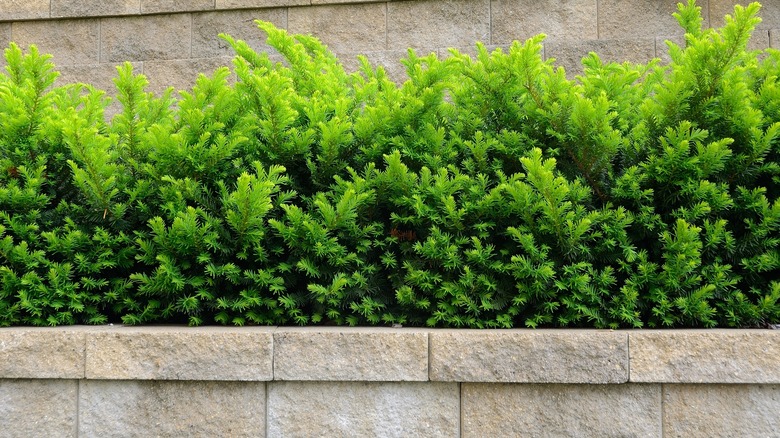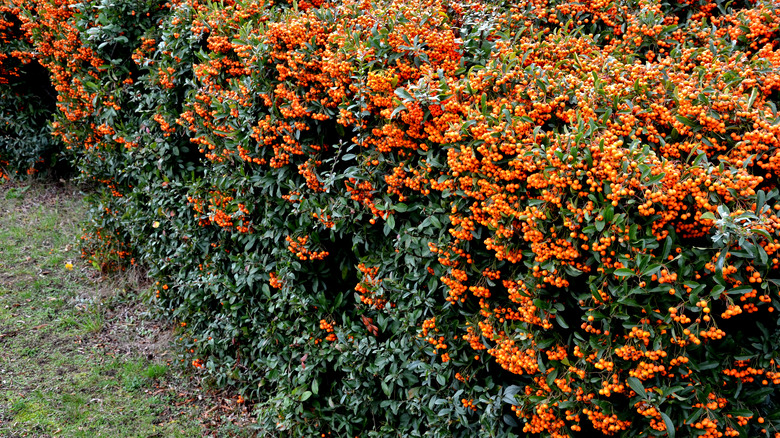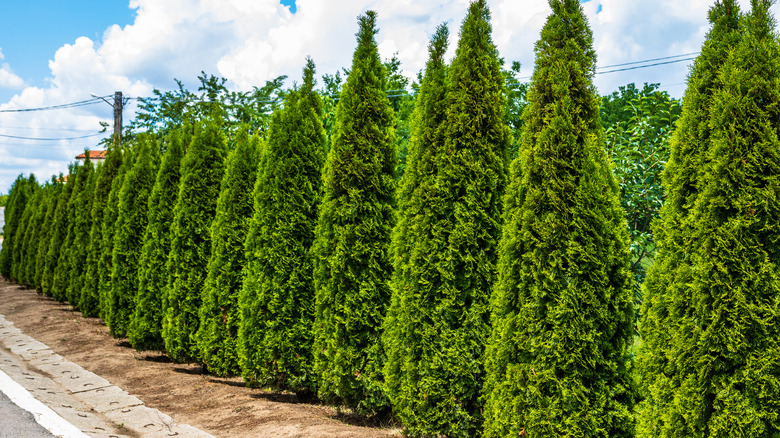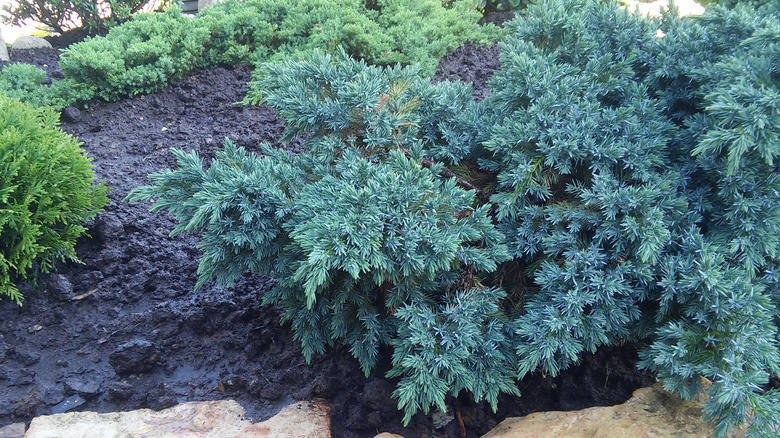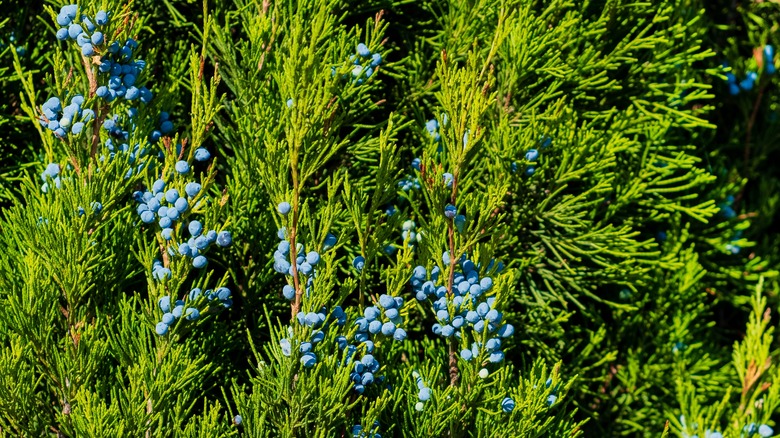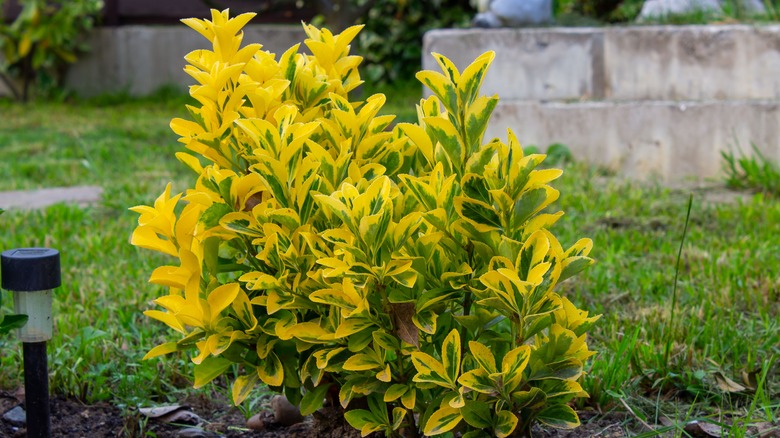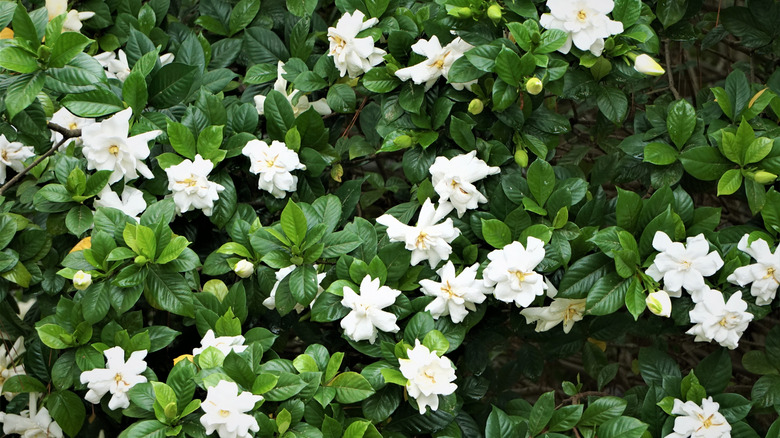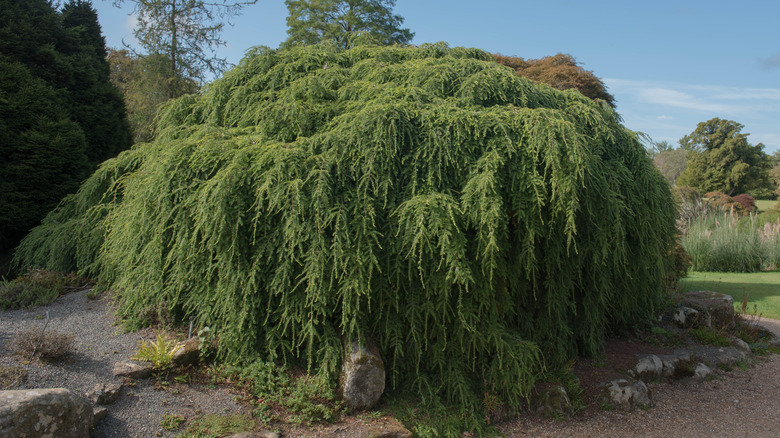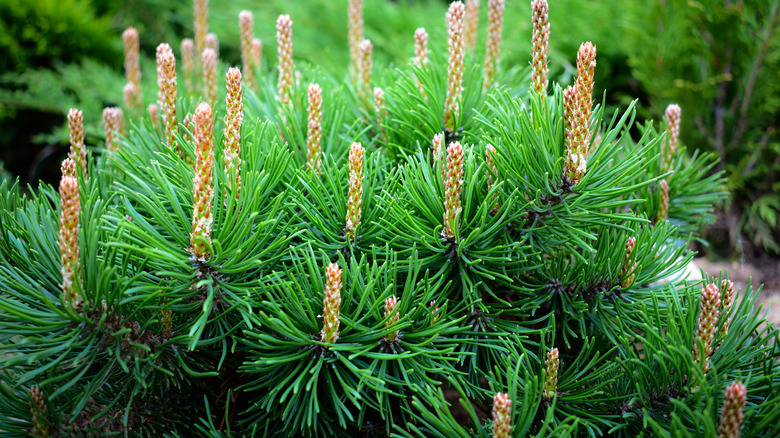17 Evergreen Shrubs To Make Your Landscaping Look Great All Year
There is plenty to love about evergreen plants – especially shrubs. Whether you enjoy the year-round color they add to your landscaping or the privacy they can provide, shrubs are a perfect choice for large and small areas. The good news is there is an abundance of varieties to choose from. You can opt for some that provide pops of color with seasonal blooms or go with others that give your outdoor space color apart from the traditional bright green leaves that are commonly associated with shrubbery.
While there are many varieties to choose from, it is best to know which kinds of plants will fare well in your hardiness zone. Another thing to consider is how tall or wide the bush will get because some shrubs are small trees, and they can grow fairly tall if you let them. Also, consider how much maintenance shrubs will need in making a choice.
1. Boxwood
Boxwood shrubs (Buxus) are actually trees, but dwarf varieties have been cultivated over the years to be rather small with tightly-packed, light green leaves. These plants have shallow roots, so use mulch to keep the soil from drying out. Place mulch about 2 inches from the trunk and cover an area about one foot wide. When planting, choose a spot that is safe from heavy winds. Fertilize once in spring with a general fertilizer to encourage growth, keeping in mind that they are slow to grow. Boxwoods maintain a nice shape without much pruning, so if you don't want to devote a lot of time to your shrubs, this might be a good choice. However, if you decide to prune, The Spruce suggests doing so in the late fall.
Bloom Season: Early spring
USDA Growing Zone: 5 to 9, depending on the variety
Growing Conditions: Full sun to part shade
Soil Type: Moist, airy soil
Size: Ranges from 2 to 8 feet tall
2. Holly
While holly bushes (Ilex opaca), with their bright red berries and shiny green leaves, are often associated with the Christmas holiday, they stay lovely year-round. Because these plants are dioecious, you'll need both male and female cultivars planted close together if you want a shrub that produces berries, and they'll need to be pollinated by bees and butterflies. The best time to plant holly bushes is in spring or autumn, and for the most part, they require little maintenance. You might want to apply a few inches of mulch to the soil (avoid touching the trunk) to keep it from drying out. Unless your soil is poor, you do not need to fertilize holly bushes. You may also want to consider the blue and Japanese cultivars.
Bloom Season: Spring and summer
USDA Growing Zone: 6 to 10
Growing Conditions: Partial shade to full sun
Soil Type: Loamy, acidic
Size: Up to 10 feet tall and 5 feet wide
3. Laurustinus
If you're looking to add a splash of color to your lawn, then maybe you should consider a Laurustinus (Viburnum tinus). These plants are bushy and have colorful, fragrant clusters of tiny white blooms. After the blossoms fall away, they reveal bright, blue berries. Laurustinus are easy to grow, and their flowers add color in colder months. Like Boxwood shrubs, Laurustinus bushes don't require a lot of pruning, but you might want to trim back longer branches in summer, per Gardenia. Laurustinus shrubs can grow up to 2 feet per year and generally only need fertilizer once in the spring. Garden Design notes that making sure leaves and branches get good circulation will prevent diseases such as downy mildew, powdery mildew and gray mold, and leaf spots.
Bloom Season: Winter and early spring
USDA Growing Zone: 8 to 10
Growing Conditions: Full sun or partial shade
Soil Type: Moist, well-draining
Size: Up to 8 feet tall and 6 feet wide
4. Mountain Laurel
Mountain Laurel (Kalmia latifolia) shrubs are evergreens that you need to choose based on your climate because they can be challenging to care for. They grow slowly, so HGTV recommends buying a nice-sized shrub from a nursery. When planting, consider your soil type and, if it contains clay, add compost to encourage better drainage and prevent root rot. It is also suggested that you don't cover the plant where the roots meet the trunk because that may cause it to rot. While Mountain Laurels can grow in full sun, they prefer a shady area with no more than four hours of sun a day. Use a fertilizer made for plants that prefer acidic soil. Don't prune heavily, as it could take years for the branches to grow back. Keep in mind that all parts of these plants are toxic.
Bloom Season: Spring
USDA Growing Zone: 5 to 9
Growing Conditions: Shade
Soil Type: Acidic
Size: 3 to 15 feet tall
5. Yucca
For something different, you could go with a Yucca shrub (Yucca filamentosa). These plants have long, stiff, and pointed leaves, and they bloom once a year in the late summer. Even the blooms are unique — the white, bell-shaped flowers shoot up from a stalk from the center of the plant. Yuccas like it dry and can sustain drought conditions. They can handle full sun and only need fertilizing once a year. You may want to prune the plant in the spring to control growth, but it isn't necessary. You don't even have to trim dead leaves at the bottoms of the plant. However, you will want to remove the dead flower stalk, per Plant Care Today. Slugs and snails like to make their home in between the thick Yucca leaves. If you notice the pests, a simple solution is a light sprinkle of diatomaceous earth around the base of the plants.
Bloom Season: Summer and early autumn
USDA Growing Zone: 3 to 10
Growing Conditions: Full sun
Soil Type: Dry, well-draining
Size: Up to 30 feet tall
6. Rhododendron
Another blooming shrub that is slow-growing is the Rhododendron (Rhododendron ferrugineum). That said, the fragrant pink blooms are worth the wait. Sometimes confused with azaleas, Rhododendrons have up to 10 buds in each blossom. When planting, place them in an area where they will have protection from high winds. These evergreens like dappled shade. Too much sun will bleach the leaves, and too much shade prevents blooms. The Farmer's Almanac points out that larger leaves need more shade. Applying a balanced fertilizer once a year in the spring should be enough if the conditions are right. Avoid any products that include aluminum sulfate, as it can cause the roots to stop growing. The American Rhododendron Society suggests pruning after the flowers have bloomed. This is also a good time to remove any dead foliage and reshape the plant.
Bloom Season: Late spring
USDA Growing Zone: 4 to 8
Growing Conditions: Dappled shade
Soil Type: Loose, Well-draining
Size: 3 to 6 feet
7. Mahonia
If you like yellow, perhaps the Mahonia (Mahonia bealei) is more your style. With holly-like leaves and spike-shaped, yellow flowers that bloom in late winter, Mahonias are a colorful addition to any lawn. Dark blue berries follow the blooms in the spring, lasting through July. These plants prefer spots that are shady with a little bit of sun. If grown in more shade than sun, the foliage will appear to be a blue-green shade, according to the University of Arkansas Extension. Keep in mind too much sun will burn the foliage. These easy-to-grow plants only need watering once a week and can tolerate dry spells. Texas A&M Extension says you will need to fertilize them about two to three times a year for them to thrive. Another plus about Mahonias is that they don't typically have issues with disease or pests.
Bloom Season: Winter
USDA Growing Zone: 6 to 8
Growing Conditions: Sun to partial shade
Soil Type: Well-draining
Size: Up to 6 feet tall and 5 feet wide
8. Mirror plant
The Mirror plant (Coprosma repens) gets its name from its shiny, rounded leaves. Some varieties feature green, yellow, pink, and purple variegated leaves. If you have trouble growing shrubs, then Mirror plants could be just what you need because they can survive in tough situations. They can even endure a lack of water during hot seasons — just don't let them go too long without a drink. In addition, don't overwater them, as they might suffer from root rot. Mirror plants grow quickly and produce small, white blooms in the summer, which fall away to green or reddish berries in the autumn. Using a balanced fertilizer once in the spring is usually enough to keep these plants happy. Gardening Know How suggests pruning twice a year to keep the plants from looking gangly.
Bloom Season: Summer
USDA Growing Zone: 8 to 11
Growing Conditions: Full sun to partial shade
Soil Type: Well-draining
Size: Up to 10 feet tall and 3 feet wide
9. Yew
For something different, try a Yew (Taxus) shrub, which features needles, cones, and red berries. Having a reputation for being easy to grow, yews can also adapt to various conditions, but they don't tolerate extended periods of extreme cold or heat. For best results, place them in an area where they will get several hours of sunlight per day. Yews can grow tall, so they make perfect privacy hedges. That said, you can prune them to keep them the size you prefer. If you prune them, The Spruce recommends doing so in the spring. You should also fertilize in the spring using a formula enriched with nitrogen. Keep in mind that the needles, bark, and fruit are all toxic to humans, as well as most pets.
USDA Growing Zone: 2 to 10
Growing Conditions: Full to partial sun
Soil Type: Well-draining
Size: Up to 60 feet tall and 20 feet wide
10. Firethorn
If you're looking for an evergreen shrub that provides pops of color just about all year round, then a Firethorn (Pyracantha) might be just what you had in mind. In the spring, these plants produce small, white flowers that are followed by bright red berries that last well into the winter. Firethorns are not too picky about the kind of soil you plant them in, but they prefer a moist soil that drains well. If they sit in soil that is too soggy, they might fall victim to fire blight. When fertilizing, avoid too much nitrogen because this will prevent the plant from producing fruit. They grow fast, so you might be tempted to prune them often. Gardening Know How suggests pruning no more than one third of the plant to encourage growth.
Bloom season: Spring
USDA Growing Zone: 6 to 9
Growing Conditions: Full to partial sun
Soil Type: Well-draining
Size: Up to 16 feet tall and 6 feet wide
11. Arborvitae
American arborvitae (Thuja occidentalis) are narrow, columnar evergreen shrubs that can quickly grow into tall trees. To keep yours at a reasonable size, be prepared for regular pruning. Arborvitae line up nicely in rows to create a border or additional privacy. If you're using them to create a hedgerow, plant each shrub 3 feet apart, and get ready for a wildlife party. They'll be nibbled on by small and large visitors alike, all while being turned into homes by a number of bird species. Like arboreal King's Guards, landscape designers will often use two arborvitae shrubs to frame each side of an entryway. The genus name thuja comes from the Greek for perfume. So, rub the foliage between your fingers to release a divine scent.
Bloom Season: Does not flower
USDA Growing Zone: 2 to 7
Growing Conditions: Full sun
Soil Type: Acidic loam to wet clay
Size: 20 to 40 feet tall and 10 to 15 feet wide
12. Blue Star or Creeping Juniper
For a striking splash of color differential, situate a blue star juniper (Juniperus squamata 'Blue Star') amongst your greener shrubs. Topping out at 3 feet tall, this low-lying evergreen will spread nicely as ground cover. It's compact, dense, and perfect for a rock garden. If you like the look and feel of wispy juniper foliage but have a wider spread ranked higher on your list of must-haves, go for the creeping varietal (Juniperus horitzontalis). Creeping juniper will give you significantly more ground cover but in a more typical shade of green. Both cultivars of this shrub will pretty much take care of themselves. They can tolerate a range of soil conditions, even growing well if your yard is full of rocks, but they don't fare well in soggy soil.
Bloom season: Does not flower
USDA Growing Zone: 3 to 9
Growing Conditions: Full sun
Soil Type: Clay, loam, or sand
Size: 1 to 3 feet tall and 4 to 10 feet wide depending on the cultivar
13. Rocky mountain juniper
On the other hand, maybe you prefer an upright juniper that will grow taller and produce bright blue berries. The Rocky Mountain variety (Juniperus scopulorum) would be perfect in that case. This is another dioecious plant that will need to be planted in close proximity to another Rocky Mountain juniper of the opposite sex. Try not to get confused by some of the other names associated with this tree. The Rocky Mountain juniper is technically a member of the cypress family (Cupressaceae) and is sometimes called the Rocky Mountain red cedar or the cedro rojo. The berries are edible, if pungent, but are more often boiled down into a wax that gets used to fragrance candles.
Bloom Season: Spring
USDA Growing Zone: 3 to 7
Growing Conditions: Full sun to partial shade
Soil Type: Tolerant to a variety of soils, prefers dry to moist
Size: 30 to 40 feet tall and 3 to 15 feet wide
14. Euonymus 'Silver King'
Euonymus (Euonymus japonicus 'Silver King') will start off petite with yellow variegations throughout the leaves, and then grow into a dense 6-foot bush with a more silvery tone to the variegations. However, when planted in a shady spot, it will stay green. It's a very tolerant shrub; euonymus can handle anything from full sun to full shade as well as a wide range of soil types and pH levels. You'll also see these shrubs labeled as spindle bushes. It's important to note that not all species of euonymus are evergreen. For example, if silver or yellow aren't your colors of choice you might opt for something striking like Euonymus europaeus 'Red Cascade' for its scarlet-tinged foliage come fall. But that cultivar is deciduous, meaning it will lose its leaves by winter.
Bloom Season: Spring and summer
USDA Growing Zone: 6 to 9
Growing Conditions: Full sun to partial shade
Soil Type: Tolerant of many soil types
Size: 6 feet tall and 2 to 3 feet wide
15. Gardenia
Lots of people would list gardenia (Gardenia jasminoides) as one of their favorite floral scents. Gardenia bushes will grace your spring yard with gorgeous white flowers and the foliage will stay green for the entire year. These shrubs are classified as tender evergreens, which means they cannot tolerate extremely low temperatures or frost. Cold climate fans of the deliciously scented blossoms can still grow them, though. Just keep your plant potted and gradually acclimate it to a sunny spot indoors as soon as the temperatures start to drop. Similar to blueberry bushes, gardenias thrive best in slightly acidic soil and should, therefore, be planted away from concrete foundations and walls. Concrete is inherently alkaline and can affect soil pH levels and the health of some plants.
Bloom Season: Spring and summer
USDA Growing Zone: 7 to 11
Growing Conditions: Full sun to partial shade
Soil Type: Acidic
Size: 3 to 8 feet tall and wide depending on the cultivar
16. Weeping hemlock
When you envision a hemlock perhaps you think of a towering 70-foot conifer set deep in the woods of eastern Canada, but there are dwarf weeping varieties too. In particular, the Sargent's weeping hemlock (Tsuga canadensis 'Pendula') will stay below 15 feet tall and spread wide in a mounding and arching manner. These shrubs are notoriously complicated to prune and will start to look more like a shaggy blob than an elegant ornamental. When this inevitably happens to your once gorgeous statement shrub, it's a clear sign that you need to call a tree specialist for a good trim. Though similarly named to the toxic poison hemlock, pet owners can rest assured that this tree is actually not toxic to animals.
Bloom Season: Does not flower
USDA Growing Zone: 4 to 8
Growing Conditions: Full sun to full shade
Soil Type: Moist, well-draining
Size: 10 to 15 feet tall and up to 30 feet wide
17. Mugo pine
The mugo pine (Pinus mugo), also known as Swiss mountain pine, is a wide-growing, cold hardy shrub that will invite wildlife to your yard and provide them with some comfy digs to call home. It has the potential to grow rather tall but it's also available in dwarf varieties that will top out at a height of 10 to 15 feet with the bonus of not needing to be pruned very often. Look for cultivars like 'Compacta' or 'Golden Mound' which turns from green to gold when it gets cold outside. Mugo pines offer seasonal pine cones and will pair nicely with any of the junipers listed above if you'd like to introduce color contrast while staying within the needled evergreen category.
Bloom Season: Spring and summer
USDA Growing Zone: 2 to 7
Growing Conditions: Full sun
Soil Type: Well-draining loam or sand
Size: Up to 25 feet tall and 30 feet wide
